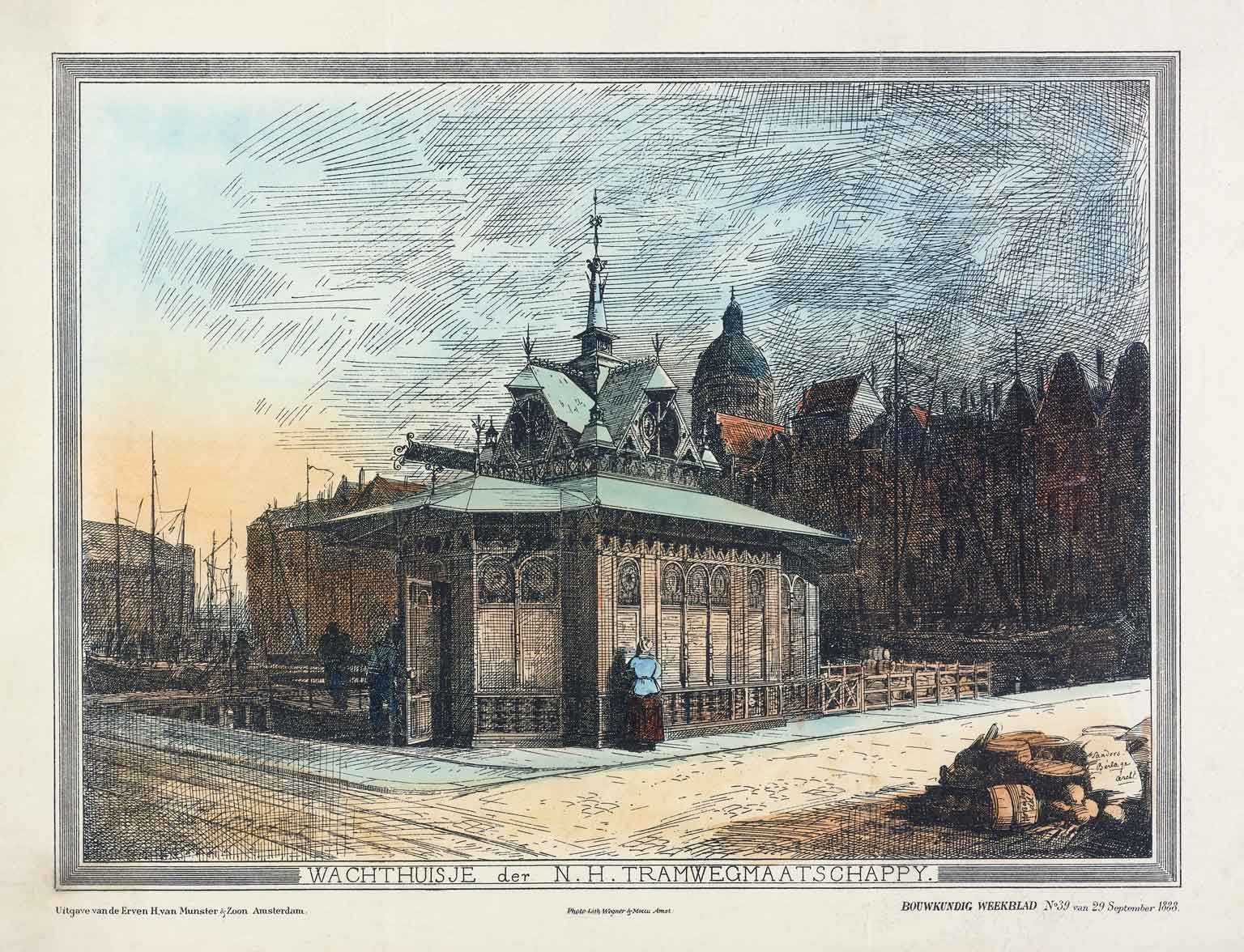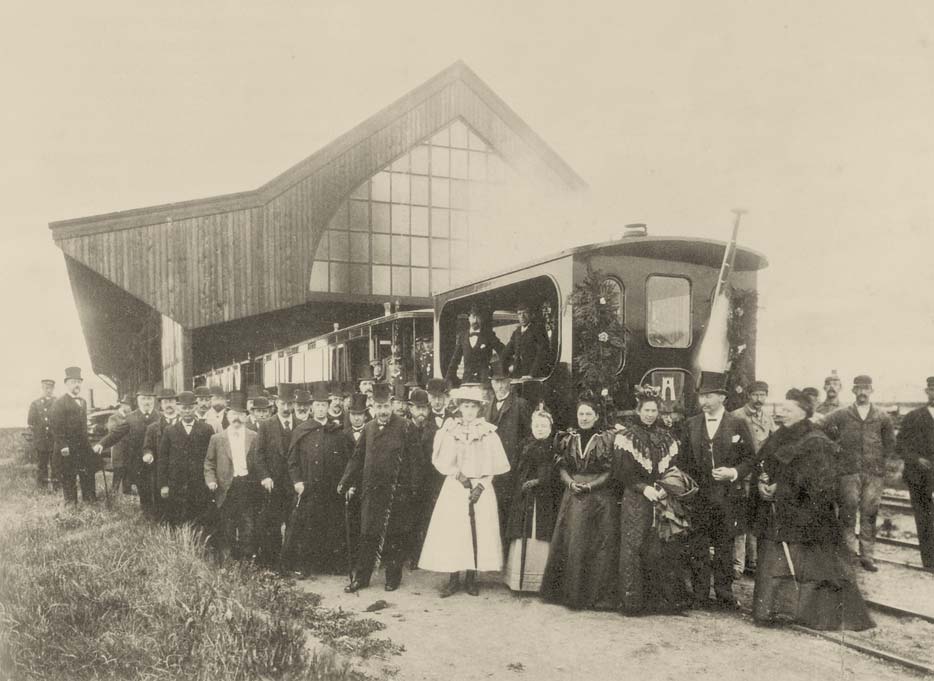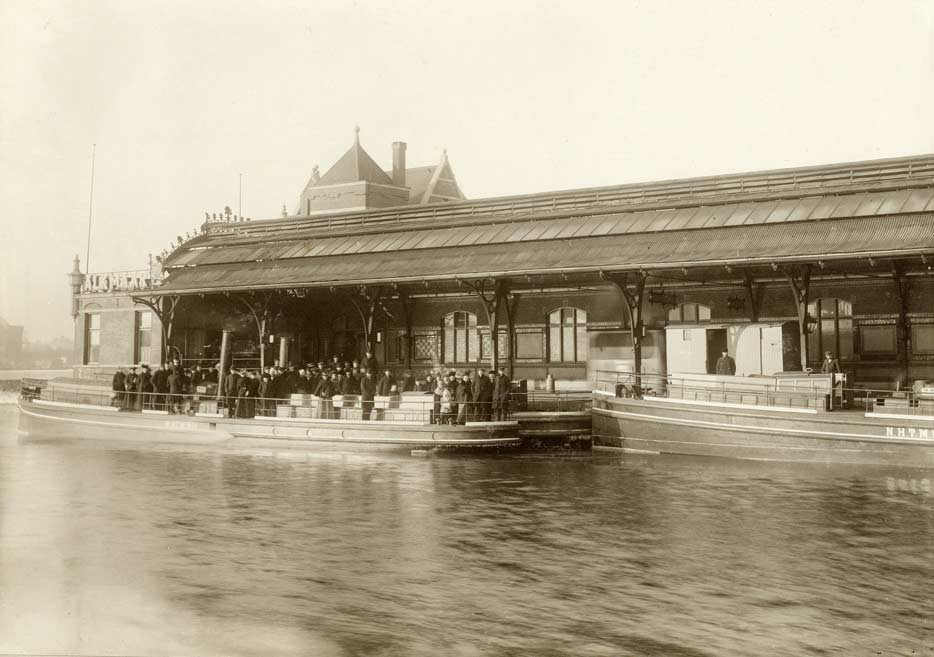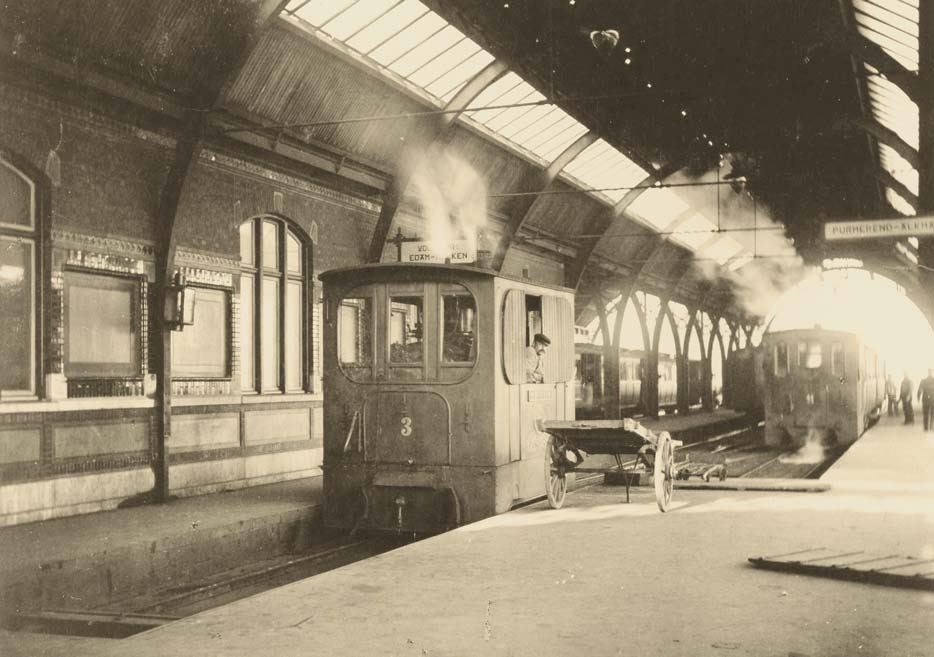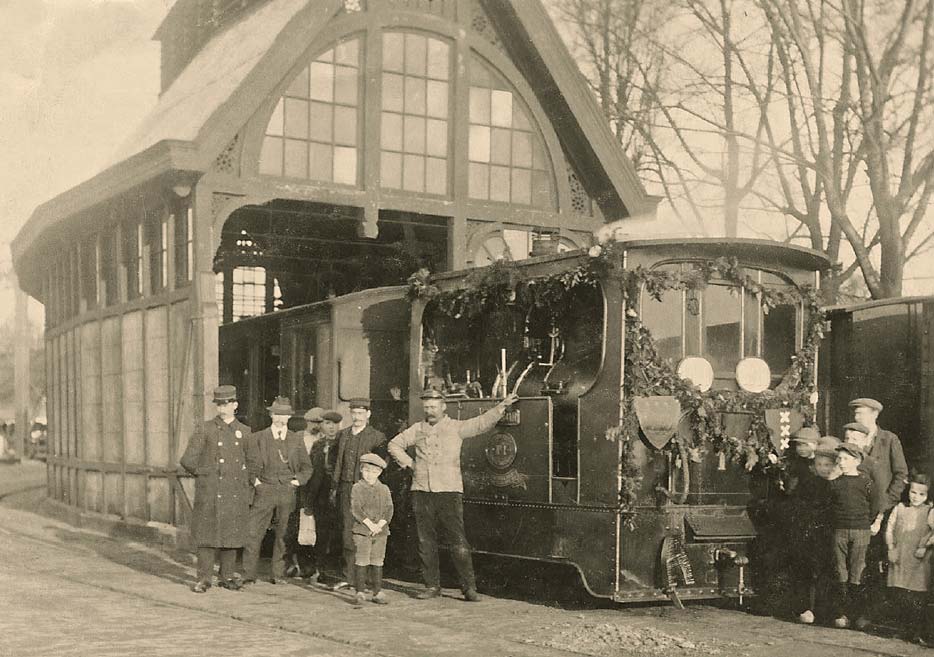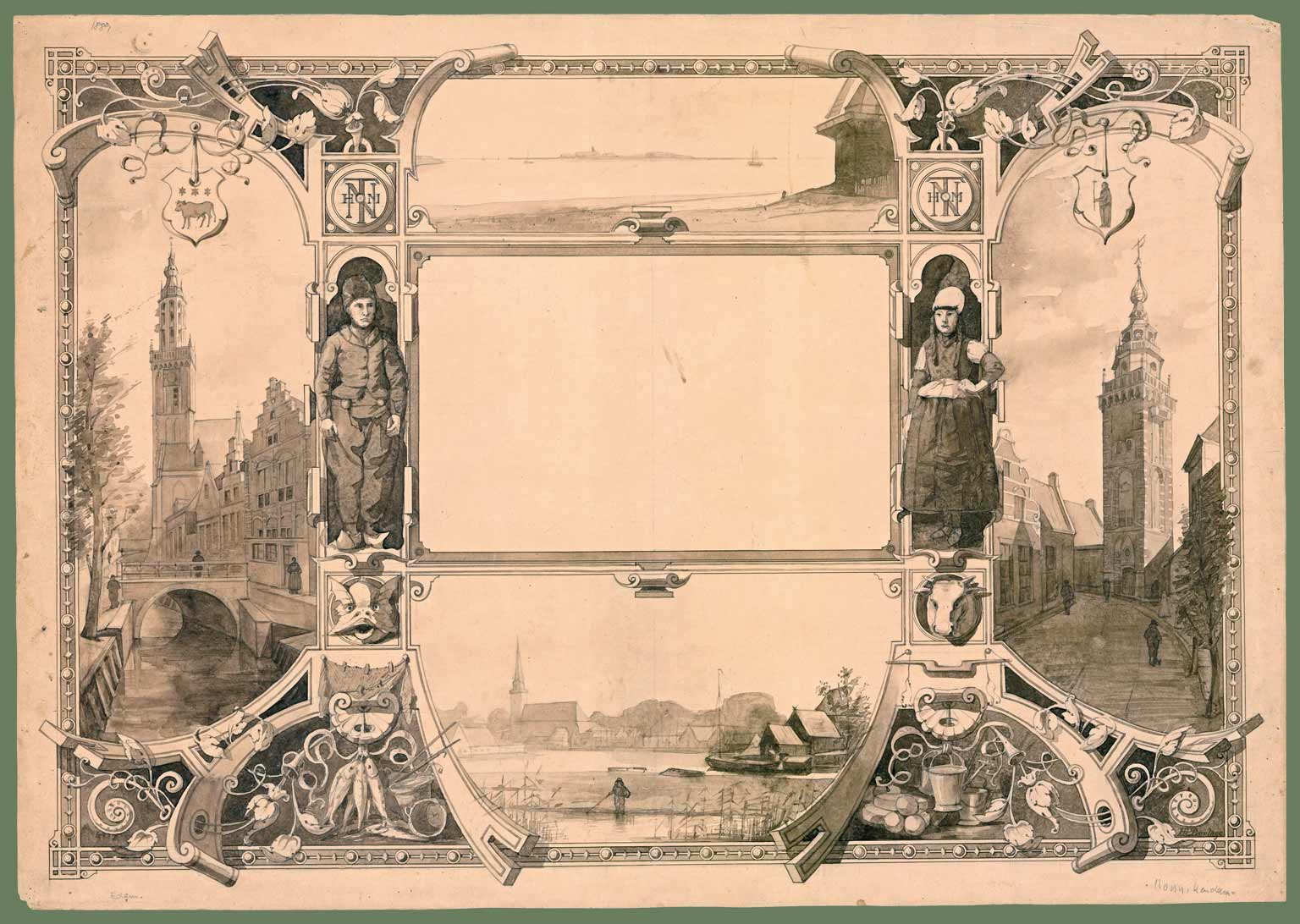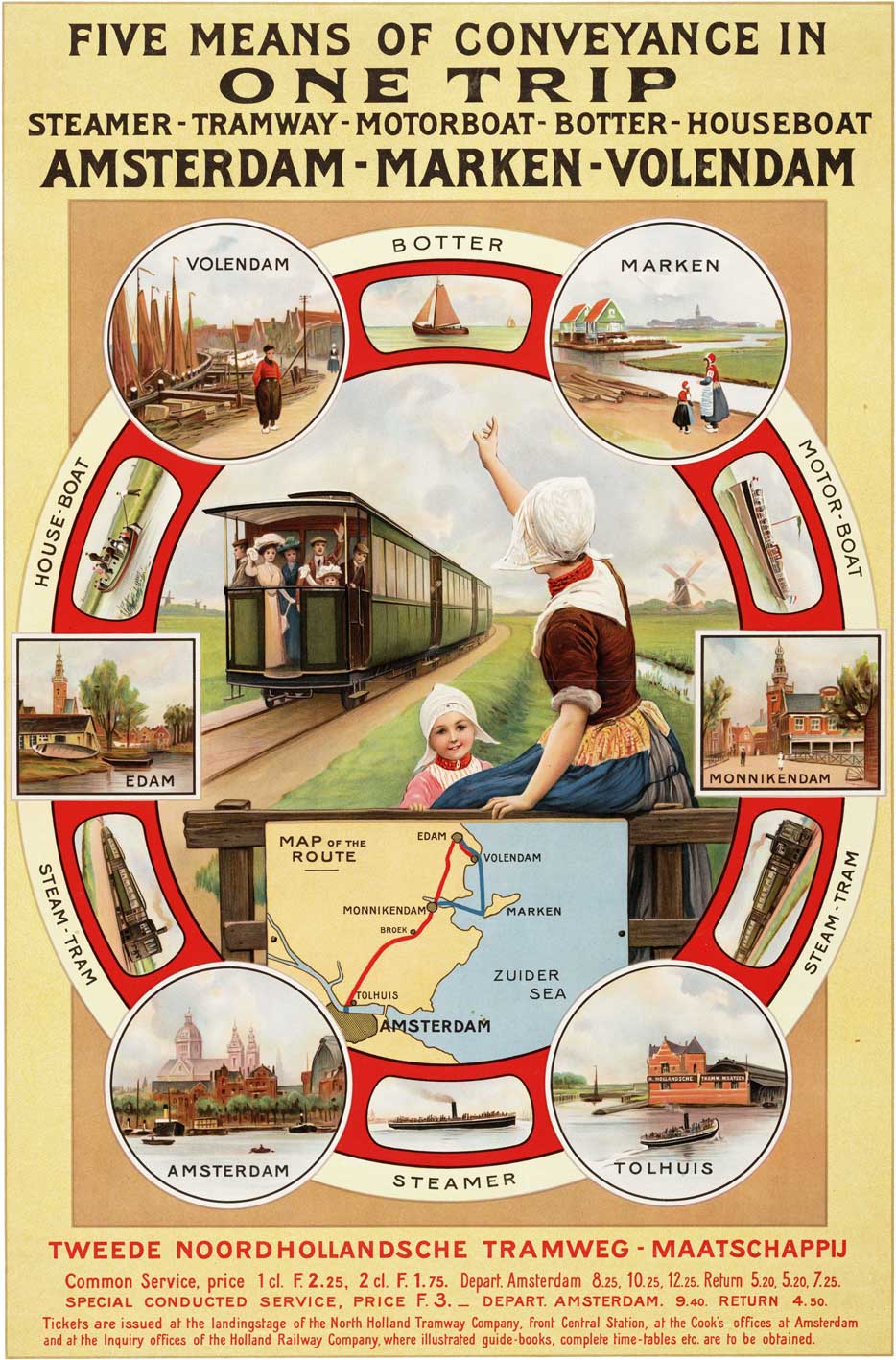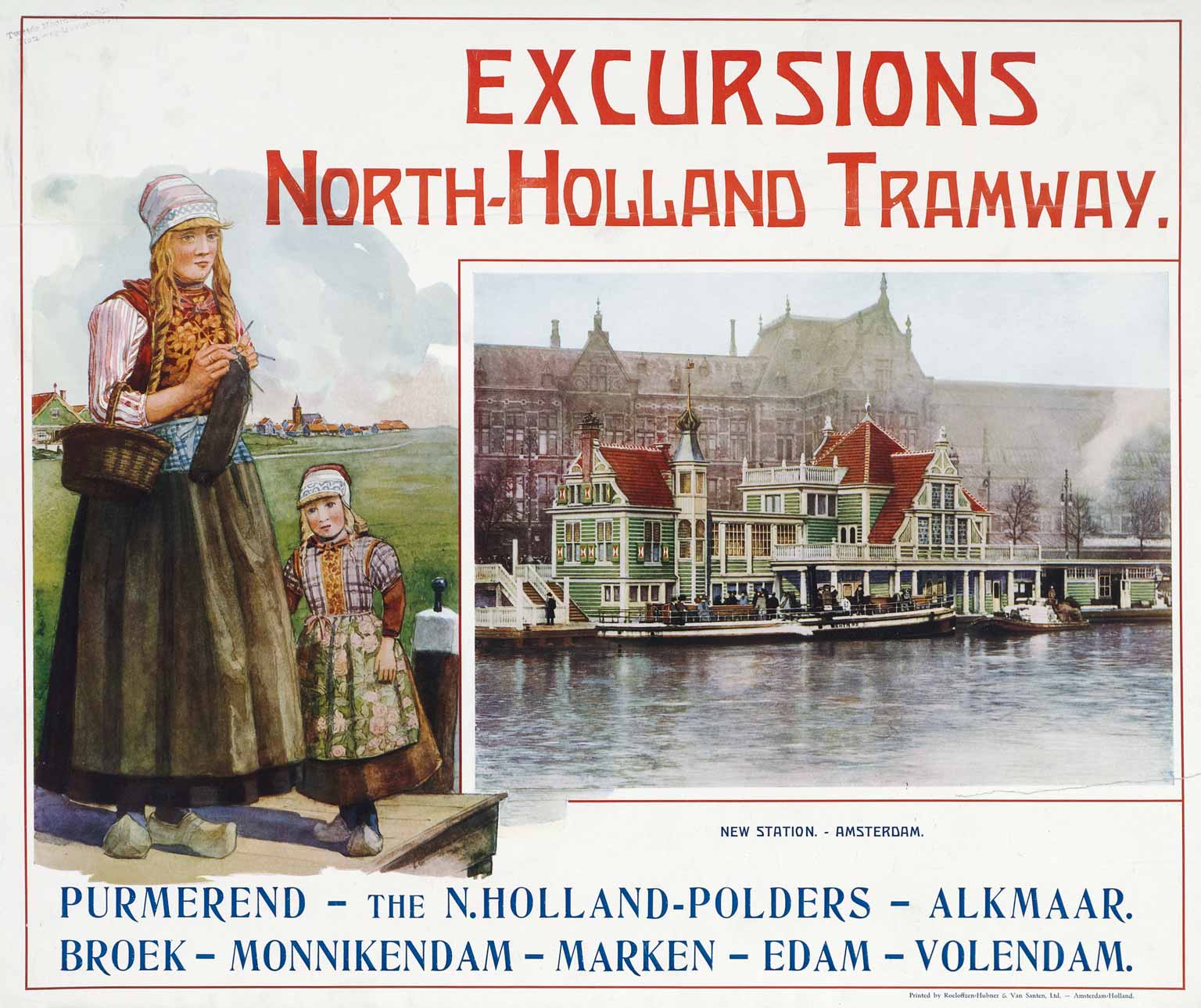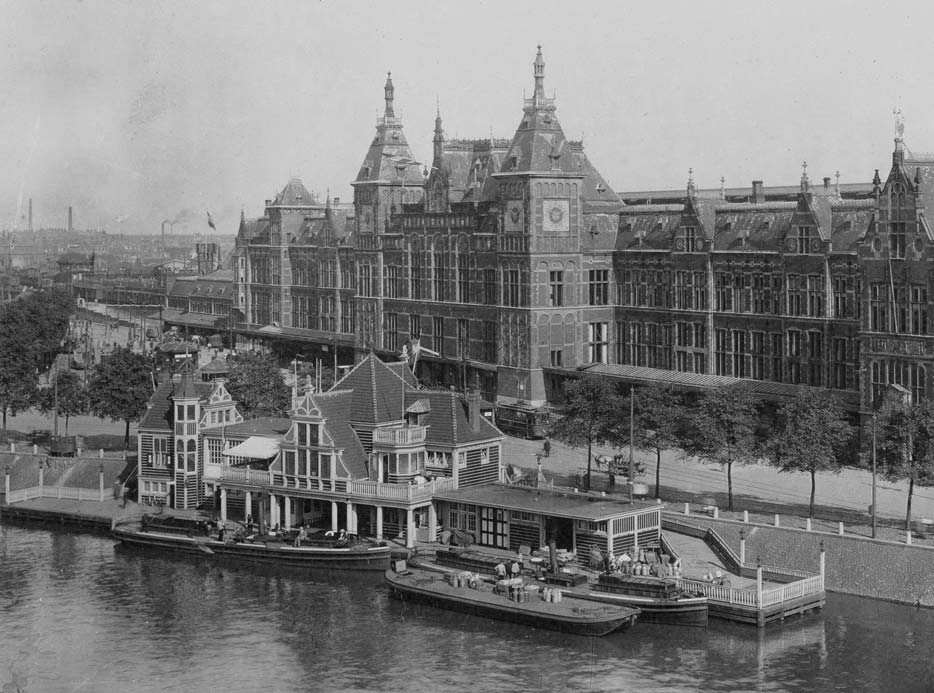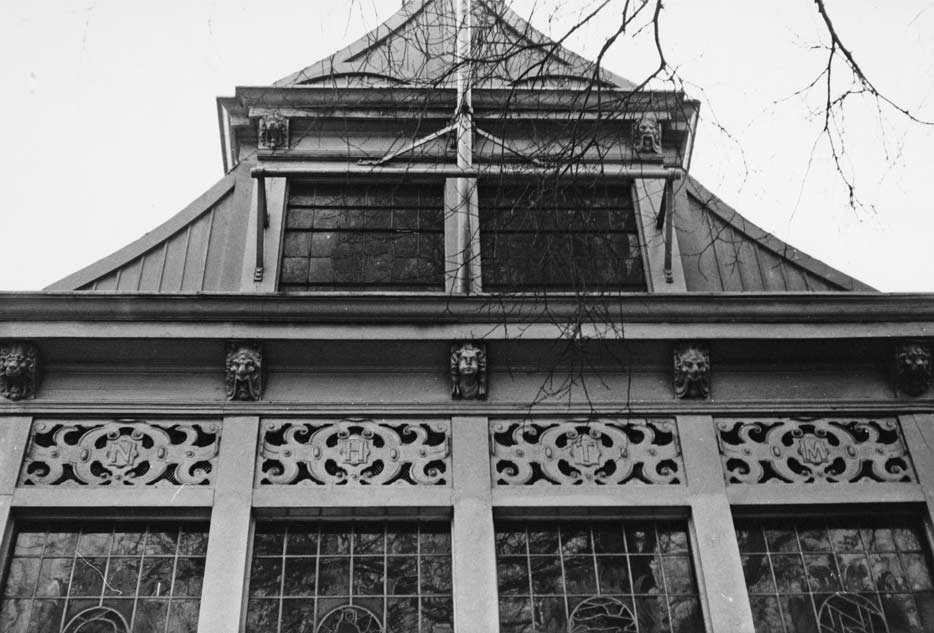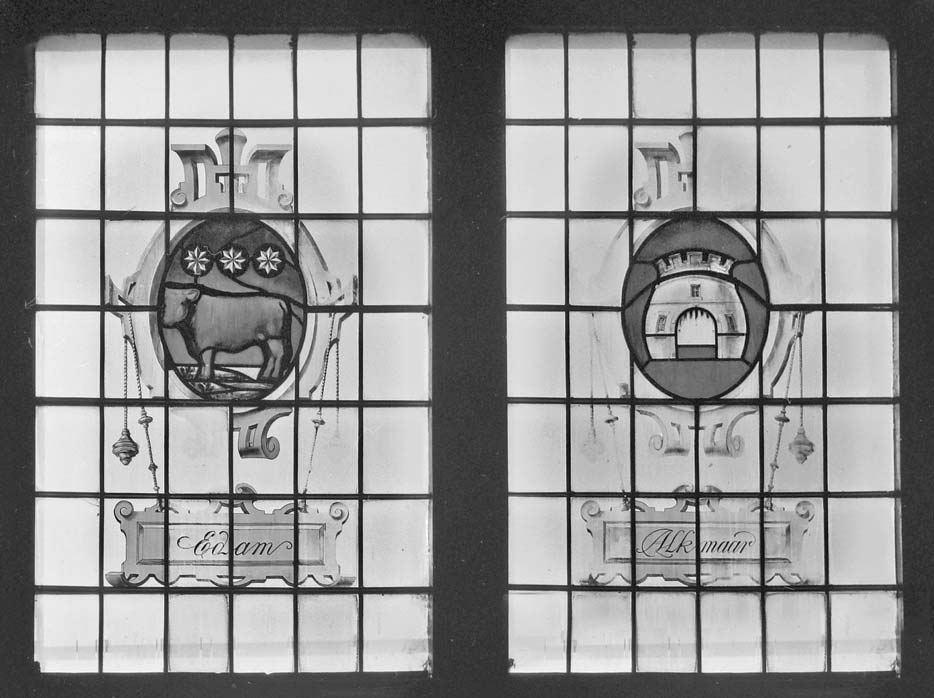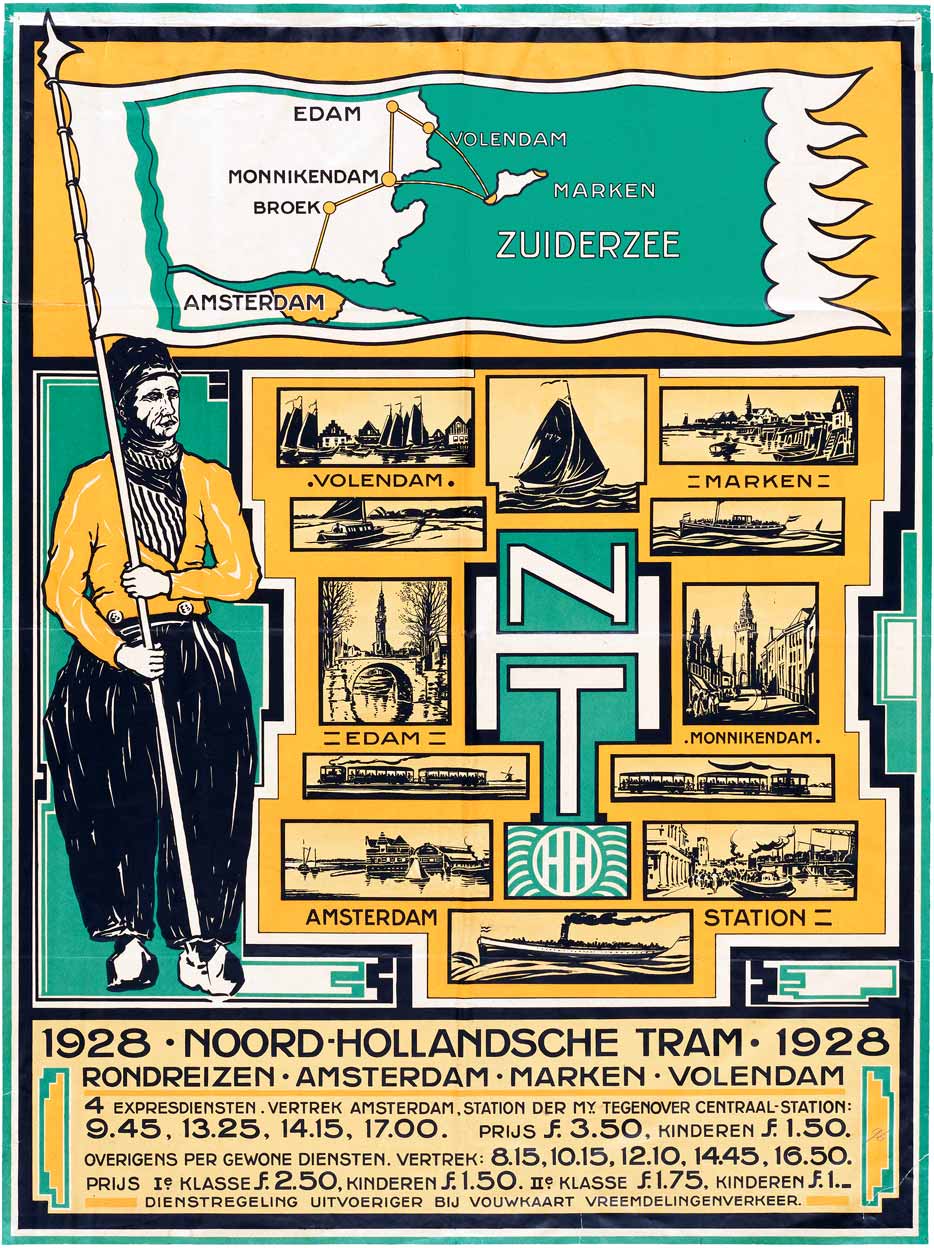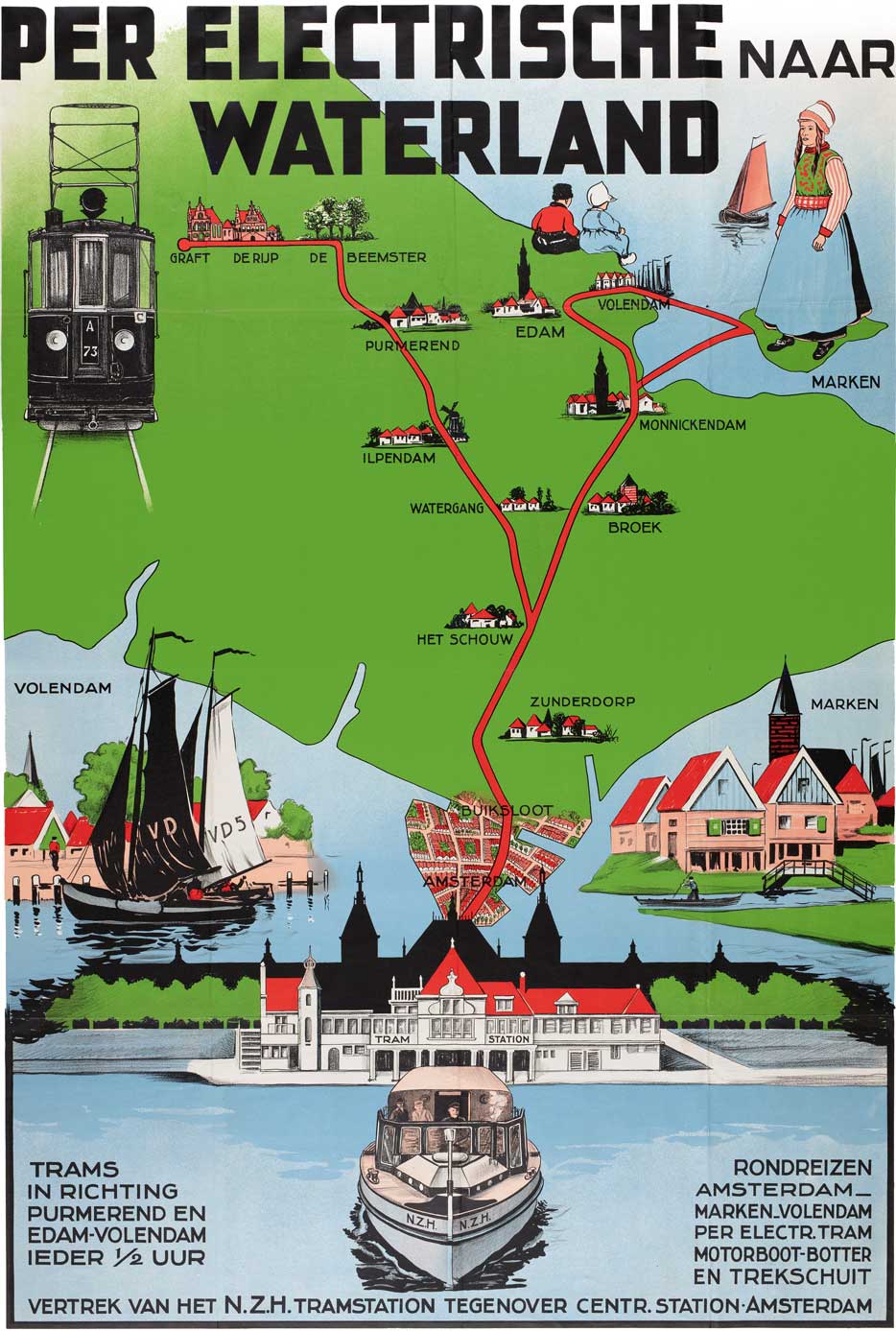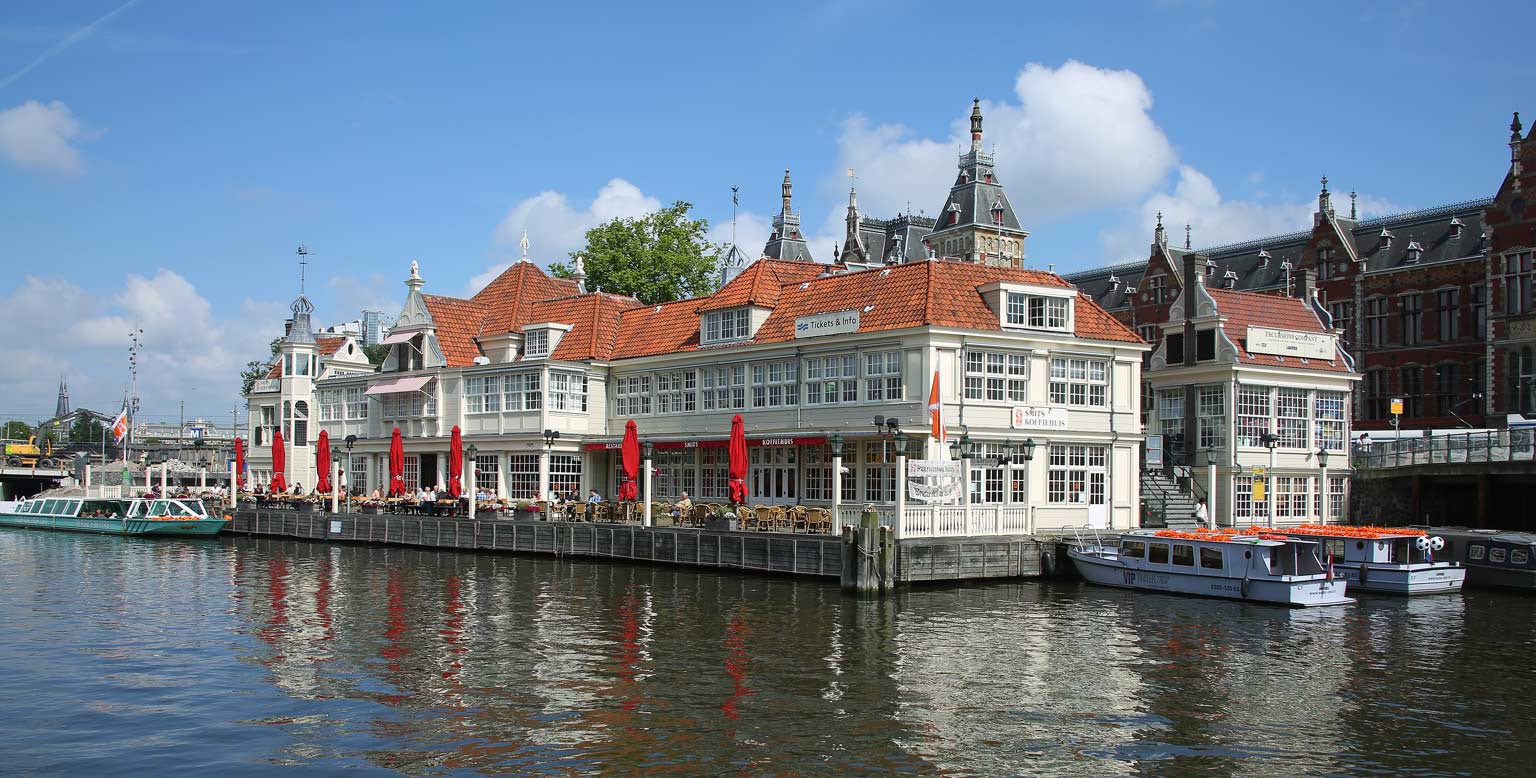The North-Holland Tramway
Posters and stations
 Nederlandse versie
Nederlandse versie
Around 1900 the Netherlands had an intricate network of regional steam tramways. The North-Holland Tramway above Amsterdam was one of the first tram companies to actively advertise at the end of the 19th century. Domestic and foreign tourists were made aware of round trips to Marken and Volendam.
The early posters and the first wooden tram stations were designed by H.P. Berlage, who would become one of the most famous Dutch architects. He was the associate of the tramway's founder. Later posters were created by other designers, as was the tram boat station in front of Amsterdam Central Station, which became known as the North-South Holland Coffee House.
First stations
Since December 1888 the North-Holland Tramway (NHT) connected the northern part of Amsterdam by narrow gauge with the villages Broek in Waterland, Monnickendam and Edam. The 21-kilometer route was covered in 70 minutes. In addition to passengers, the tram also transported dairy, fish and mail. The five small, closed steam locomotives were supplied by Machinefabriek Breda.
Supported by the mayor of Edam, the NHT was founded by Theodoor Sanders (1847-1927), a civil engineer as well as an architect. Since 1883 the young H.P. Berlage was the associate of Sanders' architectural office in Amsterdam. In 1885, for example, they designed the sanatorium hotel at Baarn. Over the years Sanders increasingly focused on tramways, while Berlage became responsible for most of the architecture.
The architectural weekly of last Saturday provides in picture the neat waiting house, designed by Messrs. Sanders and Berlage for the terminus of this company in Amsterdam, in other words: the departure station of its steamboat there, located on a jetty at the corner of the Damrak and the extension of the old bridge alley on the south side of the remaining water surface.
The small building is divided into a waiting room for the public measuring 6 by 4.5 m, and an office large 2 by 3 m. It is built entirely of white American pine wood, while the base is filled with colored and glazed bricks and there is also extensive use of colored glass and decoration with faience tiles.
The starting station of the North-Holland Tramway was on the north side of the IJ waterfront, not far from the Tolhuis and near the current IJplein square. Private ferries picked up passengers in the city, initially at a waiting house on the Damrak, which was soon moved to the water directly in front of the new Amsterdam Central Station. The wooden waiting house in the then-popular chalet style was a design by Sanders and Berlage, as to be expected. They also designed the first Tolhuis tramway station along the IJ, which burned down after a few years. It was a wooden canopy with a strikingly elegant shape. Berlage's archive also contains a drawing for a simple wooden tram stop, which may have been used at the stopping places outside the city for the first few years.
The final Tolhuis station and the later stations of Edam and Alkmaar, as well as the stops in between, were probably designed by Sanders around 1895; by then Berlage was no longer involved. Tolhuis station — not fully completed until around 1900 — had a cast-iron roof and a rectangular brick extension, decorated with pinnacles, on the waterside. Large letters with the name of the tram company were readable from the water. Alongside was a dock for the ferries. The stations and stops outside the capital were in chalet style with a lot of wood and bricks in timber frames. A striking feature of the Edam and De Rijp stations was their location in a rail curve with a partly rounded canopy.
First posters
The North-Holland Tramway Company has released a timetable, which in appearance differs significantly from the timetables of other trams and railways. The departure times of the trains from Amsterdam to Edam and vice versa are surrounded by views of Edam, Monnickendam, Marken and Broek in Waterland, while a man from Volendam and a woman from Marken are each posted on one side of the timetable. Mr. H.P. Berlage earns all the credit for these drawings, while Mr. Roeloffzen & Hübner deserve a word of praise for their piece of printing art.
As Berlage had the most artistic talent, Sanders asked him to make not only presentation drawings of buildings, but also promotional posters for the tramway. As early as 1889 Berlage illustrated a poster with timetable. As far as known, no printed copy has survived, only the design drawing with an empty white box for the fine print of the timetable. The illustrations of places along the line are very detailed, surrounded by decorations including fish and dairy products, as these were delivered by tramway from the Zuiderzee fishing villages and the Waterland farms.
In addition to the line to Edam, the tramway opened a side branch to Purmerend in 1894, extended to Alkmaar the next year. The line branched off at the hamlet of Het Schouw and ran through the Beemster and Schermer polders. This brought the total length of the North-Holland Tramway's lines to 55 kilometers. Incidentally, a new company had to be set up for the expansion, the Second North-Holland Tramway Company, because the regulations of the first one did not provide for new routes. In practice the designation 'Second' was mostly omitted.

The opening of the link with Alkmaar was celebrated on July 15, 1895. For this occasion Berlage designed a striking poster, looking much more modern than his design from 1889. He probably did this as a favor to his friend Sanders, as their architectural association had ended in 1890. In addition to a winged wheel — a traditional railway symbol — the poster shows a schematic route map and the municipal arms of Purmerend and Alkmaar. The Accijnstoren in Alkmaar is recognizable in the tower at the top. The printed timetable shows that the trip to Alkmaar took almost 2.5 hours, while Edam was reached in just over an hour.
Tourism
At the end of 1903, the tramway's founder Sanders stepped down as director and was succeeded by W.A.E. Geuns. The shares partly came in the hands of the large Dutch railway company HSM. Geuns wanted to develop the touristic branch of the tramway further, mainly aimed at British tourists heading for the picturesque fishing villages of Marken and Volendam. Already before the turn of the century, a special boat tram ran on Sundays, connecting in Monnickendam to a sailboat for the isle of Marken.
In 1904 the North-Holland Tramway induced a round trip by tram and boat from Amsterdam via Monnickendam, Marken, Volendam and Edam. A special express service with an English-speaking guide was available at additional charge. Tickets were available at HSM stations, hotels and travel agencies such as Thomas Cook & Son. Cook organized a 'lunch à prix fixe' for tourists at the Hotel Spaander in Volendam.
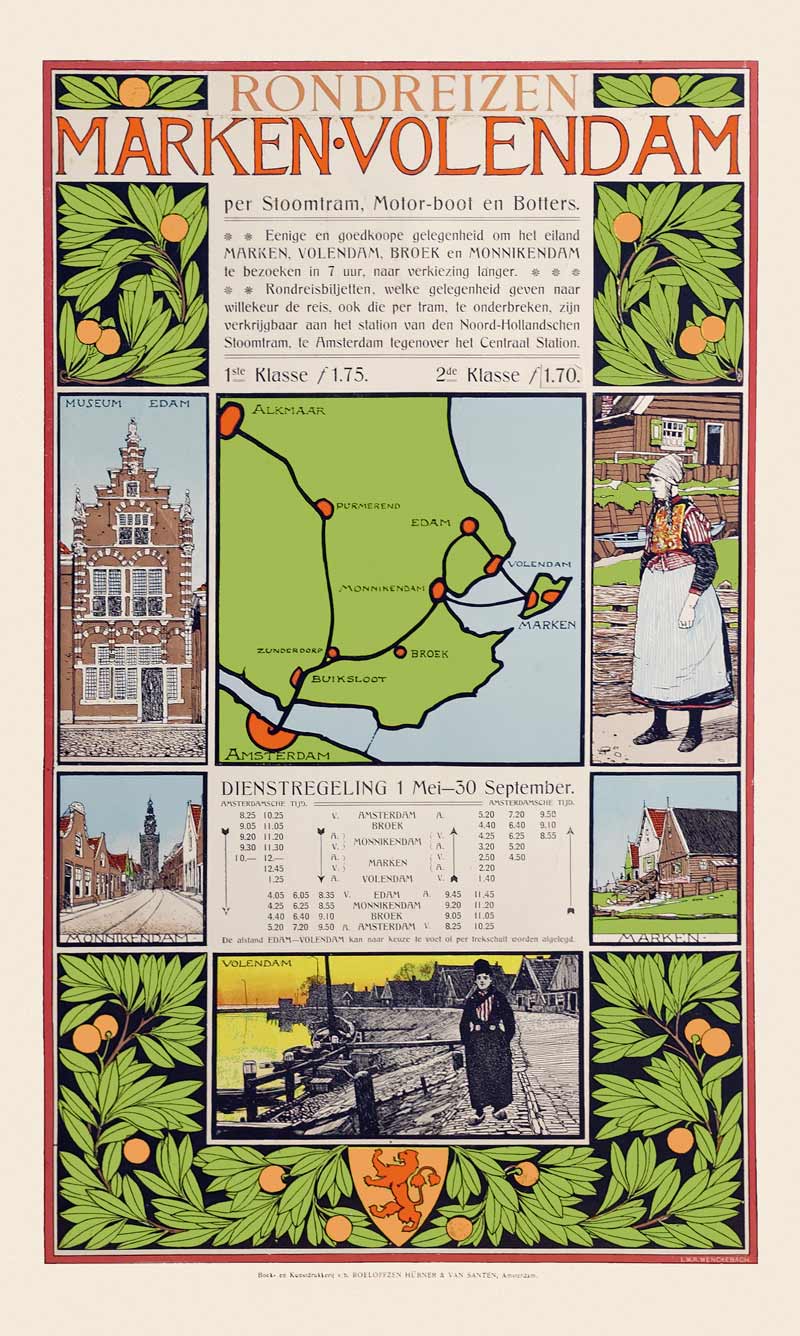


We cannot imagine the Second North-Holland Tramway Company without its systematic and well-organized advertising, for which it spares neither effort nor costs. Its neat plates with the perfectly suited images, showing the direct connection from London via Amsterdam to the five well-known places: Broek in Waterland, Monnikendam, Marken, Volendam and Edam, are known far beyond our borders. And let's not forget the guides, in four languages, in a handy format, with superb photographs and printed on beautiful vellum paper. It is all up to date!
The NHT tramway company issued richly illustrated posters, brochures and postcards for promotion. With the departure of Sanders, Berlage's lateral involvement with the tramway was over, but a friend of him took over as a designer: Willem Wenckebach. In 1905 Wenckebach created a poster with stylized pictures of the Zuiderzee villages, laced with oranges. A few years later a version appeared with a highly abstracted route map, as well as an English version in which the IJ river had become the North Sea! in 1907 rail and tramway magazine De Locomotief wrote about the successful advertising campaigns of the North-Holland Tramway: 'Well-kept illustrated guides were made available free of charge in four languages, the annual expenditure on advertising ranged from ± 500 to ± 2000 guilders'.
The slogan 'The most varied trip in Holland' became a household phrase. Around 1910 an anonymous English-language poster — more traditional in style than Wenckebach's design — promoted the roundtrip with five means of transport: 'Steamer - Tramway - Motorboat - Botter - Houseboat'. The latter was a trekschuit (horse-drawn boat) from Volendam to Edam. Since 1906, however, another option was the (separate) Volendam-Edam steam tramway, also operated by the North-Holland Tramway. In 1912 a following poster featured a detailed bird's-eye map by Leendert Grondijs, again with English promotional text. Unlike Wenckebach, Grondijs did include the branch to Purmerend and Alkmaar. Meanwhile the tramway was also offering a touristic roundtrip on that route through 'the N. Holland-polders' in collaboration with shipping company Alkmaar Packet.
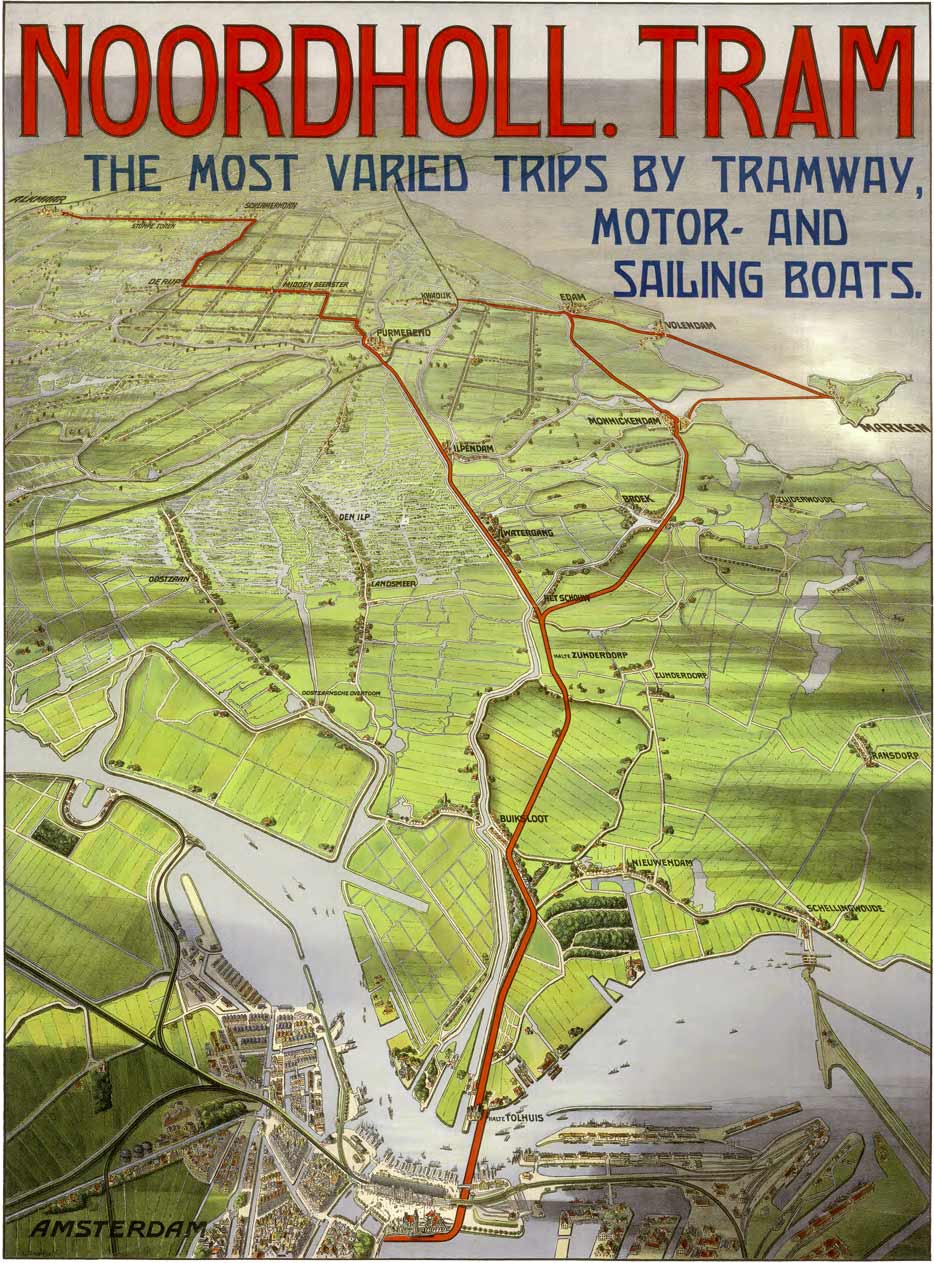
Tram boat station and coffee house
The station will be built entirely in timber and will contain a small administration building that is connected to the waiting room and buffet by a closed colonnade. The appearance is inspired by the former Paalhuis, which once stood on the corner of the Nieuwesluis, as depicted in the painting by Van Beerstraeten in the Rijksmuseum. The colonade resembles the well-known colonades that give so many old Dutch fish markets their nice appearance.
The whole building with its composite roof, its nice alternating façades and its stained-glass windows, promises to become something very typical, that will be enjoyed by the many foreigners, who visit Broek in Waterland, Volendam and Marken, and constitute a large part of the passengers of this tramway company. Last but not least, the gloom of the large canopy of the Central Station, which is so prominent on this side, will be somewhat broken by this airy little station.
In 1908 the North-Holland Tramway decided to replace the waiting house in front of the Central Station by a new tram boat station with waiting rooms, offices and a coffee house. The first plans had to be adjusted because the municipality was afraid the view of the Central Station would be blocked. The wooden structure was completed in 1912. The architect was Willem Leliman from Baarn. He was inspired by the (disappeared) 17th-century Paalhuis in Dutch Renaissance style. And the colonnade on the waterfront referred to fish markets as they existed in old Dutch cities.
The use of timber was a continuation of the first station designs by Sanders and Berlage, although their chalet style was not very old-Dutch. Leliman's design did match the traditional architectural styles of the Waterland and the Zaanstreek regions, especially the wooden boards that were painted green originally. In this way, the building doubled as a kind of advertising column for the tramway's touristic tours, right in front of Amsterdam Central Station. In decorative carvings the letters NHTM (Noord-Hollandsche Tramweg-Maatschappij, North-Holland Tramway Company) were applied, while the stained-glass windows were ornated with the arms of the places along the line, including Edam and Alkmaar.
An important part of the building was Smits' Coffee House, which remained there for almost a century. The tram boat station was expanded in style in 1931 by the architects Kleinhout and Van der Steur. The lading stage partly became a terrace. When the NHT was taken over by the Noord-Zuid-Hollandsche Tramweg-Maatschappij (NZH) in 1932, the coffee house became known as Noord-Zuid Hollandsch Koffiehuis. After the Second World War the building was painted in light colors instead of green. Due to the construction of the Amsterdam metro it had to be demolished in 1972. The building was dismantled and then rebuilt a few meters eastward in 1980. In addition, an extension was added for tourist and ticket offices.
NZH and electrification
The flood of 1916 caused great damage to the Waterland and rails and bridges, but the tramway eventually overcame this. The rise of lorries and passenger cars, and especially buses, was of a more lasting influence. Tourist tours continued to be successful, but regular services were hardly profitable anymore. The Purmerend-Alkmaar line was discontinued in 1931 and replaced by a bus service. The tram connections to Purmerend and Edam remained, but were taken over by the larger NZH. This transport company had the lines fitted with overhead wires and introduced electric trams from the former Amsterdam-Zandvoort tramway. The three types of motor trams, dating from around 1900, were nicknamed the Métallurgiques, Purmerenders and Buiksloters.
'By electric to Waterland', was the slogan on a 1932 poster. It provided nice views of the route through the green Waterland, the destinations, the trams and the Noord-Zuid Hollandsch Koffiehuis with a departing tram boat. The electric trams to Purmerend continued to run until 1949 and the branch to Edam existed until 1956. In that year the station in Amsterdam-Noord had to make way for the construction of the IJ tunnel. Today, only the Noord-Zuid Hollandsch Koffiehuis and the old tram stations in Purmerend and Broek in Waterland still remind of the North-Holland Tramway.
